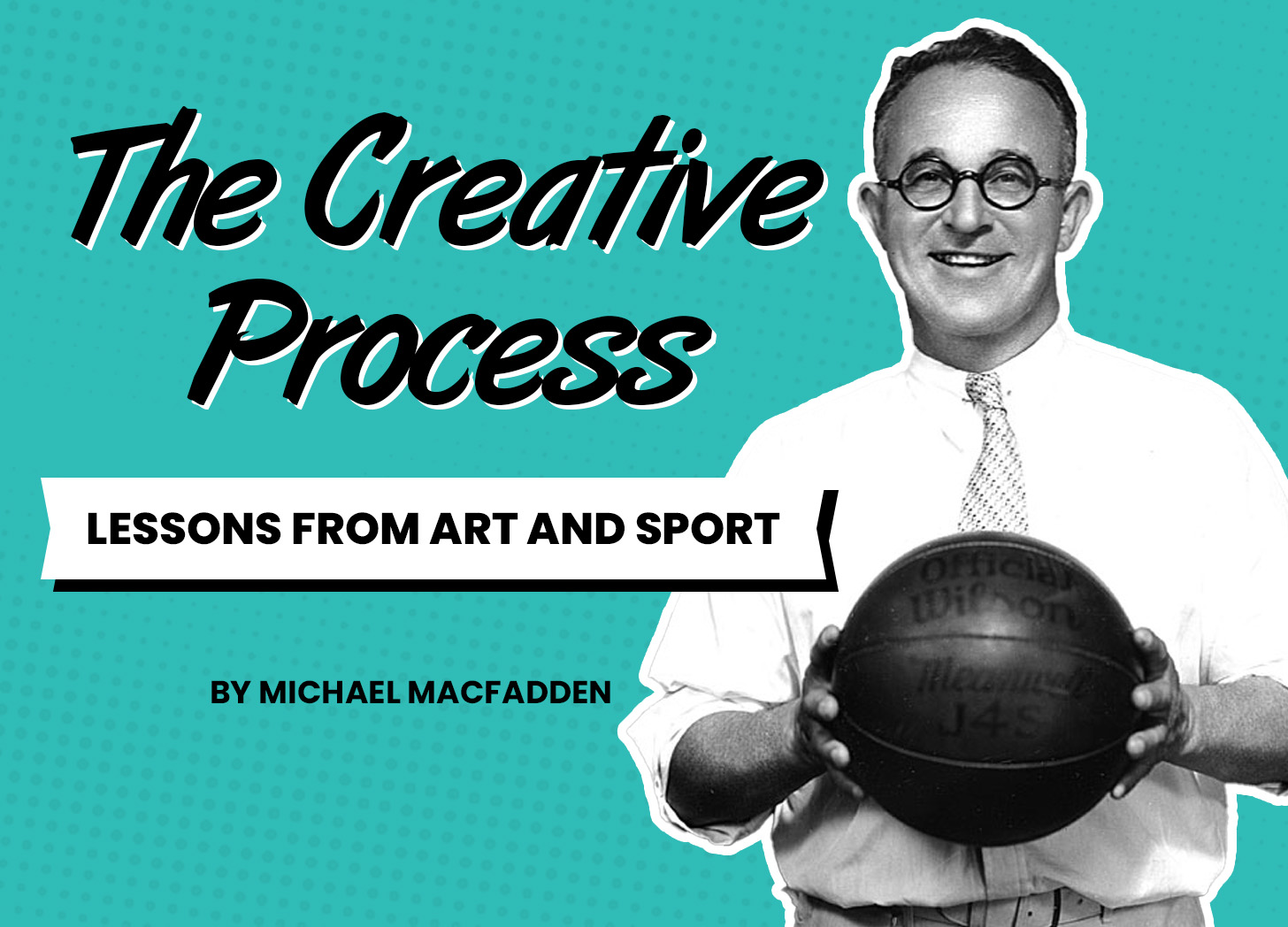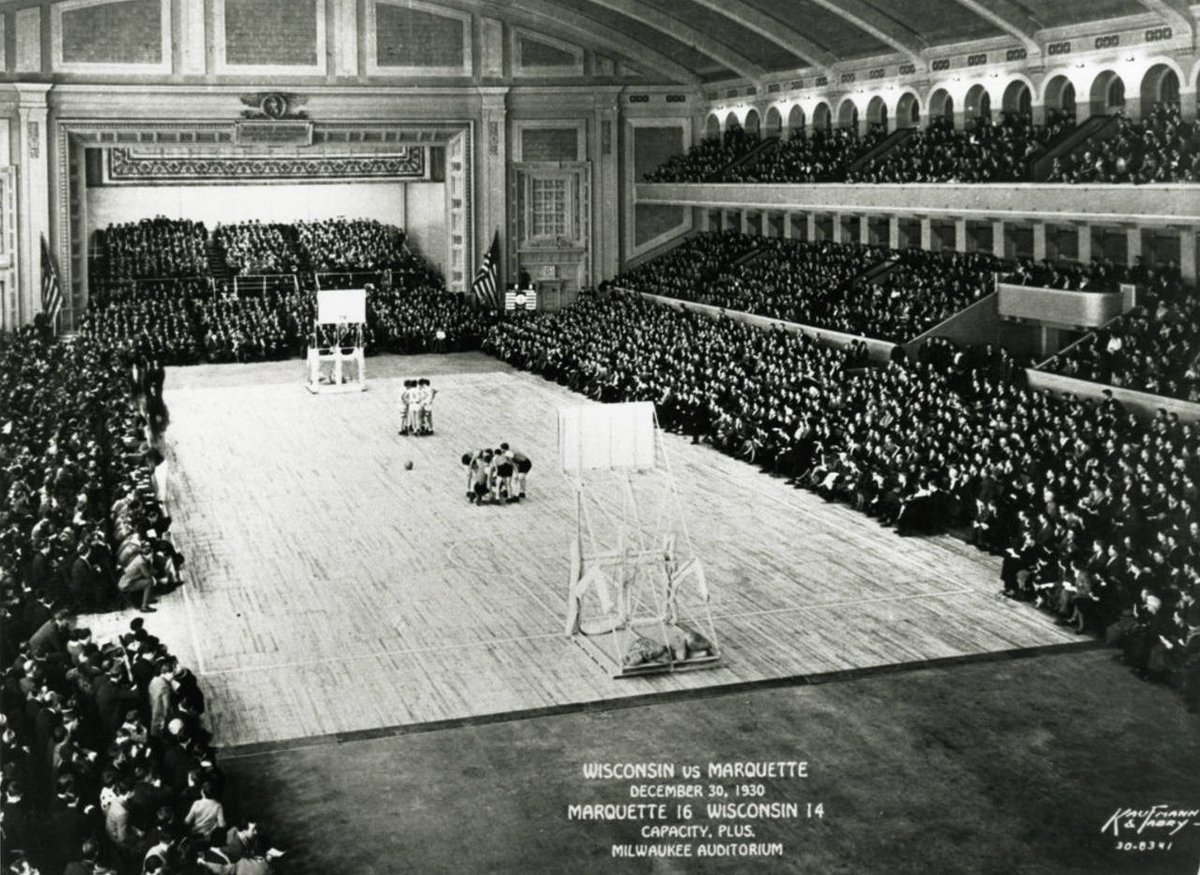From 1930s basketball scores to Ed Sheeran’s dirty tap, explore how creativity evolves and why context, practice, and humanity still matter.

Hey Friends! I’m testing out a new image style above. Would you let me know what you think of it in the comments?
Evolution
A while back, I came across this image of the Marquette and University of Wisconsin men’s basketball teams. It’s from December 30th, 1930. Like many great traditions, the rivalry between these two schools continues to this day. It’s a really cool picture and captures a unique moment in time.

Stunning architecture aside, there’s a detail in this photo that’s impossible to ignore once you see it at the bottom of the image—the final score: Marquette 16, Wisconsin 14.
Compare that to the 2025 NCAA championship: Florida 65, Houston 63. In the span of roughly 100 years, the final score of a game quadrupled. Granted, 16-14 was relatively low scoring even then, it still illustrates an interesting aspect of human nature—the tendency to progress.
I think about this a lot as it relates to creativity. The evolution of certain art forms seems to be on a fast track. Stand-up comedy ages quickly for example. Take Lenny Bruce: he pioneered the modern genre as we know it, and every working comedian stands on his shoulders. Give any of his routines a listen today, though, and you’ll find it hard to laugh. That doesn’t mean his work was bad. It means his work existed in a context that no longer exists today.
Comparing Lenny Bruce to Nate Bargatze or Dave Chappelle, would be like pairing the 1930’s Badgers with the modern day Gators. Completely unfair.
Creative works should be contextualized to the time, culture, and circumstances in which they were created.
Takeaway: When you come across a creative work that holds up to the test of time, it offers an even greater reason to hold it in high regard.
Practice In Public
A while back, the artist and writer shared an experimental sketch of a skinny wooden house. In the caption, they say:
I was trying to figure out how I wanted to render wood textures, which is why all the planks look different. Ended up quite liking the sketch despite it being a bit of a hodgepodge…
See the original below:
This brief post illustrates two important aspects of creativity:
It’s hard to predict the outcome of creative experimentation. The only way to find out is to try. In this case, the outcome was a tremendous success: exaggerated perspective, intricate grain patterns, and minimal shading combine to make a whimsical home that I’d love to hang on my wall.
Practicing in public provides you with immediate feedback. At the time of writing, this post has 69 likes, 4 comments, 2 restacks, and, as of now, at least one mention in a newsletter. That’s 76 signals of interest and feedback to inform future creative decisions.
Takeaway: If you’re procrastinating on a creative project because you’re unsure which direction to go, make a choice—and share it.
Ed Sheeran’s Dirty Tap Water
Forgive the salty language, but the video below features Ed Sheeran’s thoughts on songwriting. He likens it to turning on a dirty tap. At first, “shit water” pours out, but if you let it run long enough, it runs clear, he says. Similarly, when songwriting, the first bit that comes out is often “shit” too. If you keep at it long enough, though, the good stuff flows.
Watch the full clip below:
This advice is likely true for most creative work. It’s hard to jump directly into a flow state and produce your best work. Generally you need to first warm up to get your synapses firing and creative juices flowing.
I like the concept of a “vomit draft,” where you write with little to no concern for spelling, punctuation, or conventions. The idea being to get what’s in your head into written form as fast as possible—even if it is mostly “shit.” Afterward, you can filter it (or rewrite it) until it’s mostly clear.
Most creative disciplines have some version of this:
Artists sketch
Singers do vocal warmups
Dancers stretch
Filmmakers storyboard
Photographers take test shots
Developers wireframe
Chefs taste-test
Game designers draw level maps
If you’re frustrated by your early creative efforts, your pipes may just be gummed up. Be like Ed Sheeran and find an activity that flushes out the bad, making way for the good.
Takeaway: A bad first draft isn’t failure—it’s the first step.
Passive Creativity
shared a creative practice that he engages in compulsively: taking photos of textures, dirt, grit, and grime to be used in digital collages at a later point.
I recently wrote about capture habits—a systematic approach to gathering concepts, ideas, and articles to write about in the future. I keep a giant to-do list in the Notes app on my iPhone where I keep track of newsletter topics, for example. Conrey’s compulsion reminds me a lot of this.
See his original post below:
I like to think of these acts as passive forms of creativity—creative background processes that never really shut off. They’re like slow drips, steadily filling a well from which to draw inspiration.
It takes focus and concerted effort for me to write my newsletter. I assume the same is true for Conrey when making art. The reality is, I don’t have nearly as much time as I’d like to actually write, but by running a creative background process, my mind stays engaged and my well full. When I do find time to write, I never find myself staring at a blank page wondering what to write. My backlog of topics far exceeds my ability to turn them into full articles.
Whether you’re a writer, collage artist, painter, choreographer, or taxidermist, there’s likely some version of passive creativity that can set you up for future success.
Takeaway: While it’s easy to fall into the trap of procrastinating by learning about other people’s processes, some amount of it can be instructive. Learning from others is only procrastination if it never becomes practice.
Write For Equals
I heard a great quote on a podcast that was attributed to Tim Urban of Wait but Why. It’s only three words, but offers amazing advice to writers in search of an audience.
It goes:
Write for equals.
The idea behind the quote is that you shouldn’t write from a perspective of the all-knowing sage speaking down to intellectually inferior beings thirsty for your knowledge. Nor should you write to impress an authority who sits above you. You should write in your own voice in the same way that you would your good friend.
I couldn’t find evidence of Urban actually saying this, but the clip below features him sharing similar sentiment:
Having grown this newsletter to 1,200+ readers, it’s tempting to think more about my audience than when I was writing this for basically no one. To land somewhere in the middle of the preach-pander continuum, I try to imagine writing to just one person. My brother serves as my “equal archetype.” If I feel like he wouldn’t enjoy a segment, or I’m debating a turn of phrase, I ask myself what he’d think about it.
Last week, I included a really subtle joke in a section of my newsletter that I was unsure if anyone would pick up on. I was delighted when I received a text that read:
I’m in your newsletter! “Shared without his permission” …
A screen grab of it is below:

I had included a photo of one of my brother’s latest paintings in my newsletter, but I didn’t ask him if it was okay to share it. I just posted it and openly acknowledged that I had done so. I figured he would find that amusing, and if you did too, then you are among equals here.
Additionally, if you enjoy the over explanation of an inside joke and the meta analysis of writing about writing for equals by writing for equals, you’re definitely among equals.
Zooming out for a moment: in a world being rapidly reshaped by AI, the one thing that we humans will always have is our humanness, and that is something I try to share in my writing.
Takeaway: If your aim is to create for the broadest audience possible, you will almost certainly hit no one.
Two More Things
This Tuesday, in an effort to be creative (and not just write about it), I’ll be publishing the first chapter of my novella, Windsor Greetings, right here on Substack. Look for it in your inbox at 6:00 AM CST.
I’d love it if you gave it a read. A new chapter will follow each Tuesday thereafter until all 10 have been published.
And hey—good things are better when shared. If you liked this, it would mean the world to me if you passed it along to someone who might enjoy it too.
I’ll see you in your inbox again next week.
Until then,
-Mike

 Tiktok failed to load.
Tiktok failed to load.